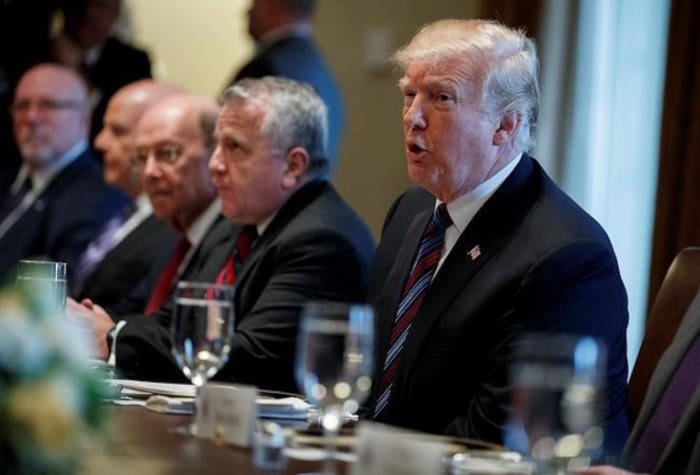President Donald Trump said Tuesday he wants to use the military to secure the U.S.-Mexico border until his promised border wall is built.
Speaking at a lunch with Baltic leaders, Trump said he’s been discussing the idea with his Defence Secretary, Jim Mattis.
“We’re going to be doing things militarily. Until we can have a wall and proper security, we’re going to be guarding our border with the military,” he said, calling the measure a “big step.”
“We really haven’t done that before, or certainly not very much before,” he said.
Trump has been deeply frustrated about the lack of progress building what was the signature promise of his campaign: a “big, beautiful wall” along the Mexican border. He’s previously suggested using the Pentagon’s budget to pay for building the wall, arguing it is a national security priority, despite strict rules that prohibit spending that’s not authorized by Congress.
The Department of Homeland Security, Pentagon and White House did not immediately respond to requests for comment on how such a plan might work.
Sending military to the border, in the form of National Guard troops, has been done before. In 2006, under Operation Jump Start, 6,000 troops were sent to the border in an effort to increase security and surveillance. The operation used the National Guard to assist border patrol with non-law enforcement duties while additional border agents were hired and trained.
The number declined during the second year to about 3,000.
Over the two years, about 29,000 National Guard forces participated in the missions, as forces rotated in and out.
The Guard members were used for surveillance, communications, administrative support, intelligence, analysis and, in some cases, the installation of border security infrastructure. Over the two years, more than 30 miles of fencing and 13 miles of road were built, and more than 86 miles of vehicle barriers were installed.
Active duty U.S. troops were not used for the operation since there are prohibitions on using so-called Title 10 troops for law enforcement and similar duties within the United States
Trump’s announcement came a day administration officials said they’re crafting a new legislative package aimed at closing immigration “loopholes.”
Trump also called on Republican lawmakers to immediately pass a border bill using the “Nuclear Option if necessary” to muscle it through, as part of a flurry of tweets on the subject over the last several days.
The president has also been declaring protections for so-called Dreamer immigrants “dead,” accusing Democrats of allowing “open borders, drugs and crime” and warning Mexico to halt the passage of “caravans” of immigrants or risk U.S. abandonment of the North American Free Trade Agreement.
Trump has been seething since realizing the major spending bill he signed last month barely funds the wall he has promised supporters. The $1.3 trillion funding package included $1.6 billion in border wall spending — far less than the $25 billion Trump made a last-minute push to secure. And much of that money can be used only to repair existing segments, not to build new sections.
Among the new measures the administration is pursuing: ending special safeguards that prevent the immediate deportation of children arrested at the border and travelling alone. Under current law, unaccompanied children from countries that don’t border the U.S. are turned over to the Department of Health and Human Services and undergo often lengthy deportation proceedings before an immigration judge instead of being immediately deported.
The administration is also pushing Congress to terminate a 1997 court settlement that requires the government to release children from custody to parents, adult relatives or other caretakers as their court cases proceed. Officials complain that many children never show up at their hearings.
The proposals appear the same as those included on an immigration wish list the White House released in October but failed to gain traction during negotiations over the border wall. Such proposals are likely to face opposition from moderate Republicans and Democrats going into the midterm elections. But Trump appears intent on ensuring the issues remain at the forefront of public conversation, even though the spending bill was widely seen as the last major legislation likely passed this year.
Trump’s past calls to for the “nuclear option” — changing Senate rules so that a simple majority of 51 votes is needed to advance legislation, instead of the current 60 votes — have been dismissed by Senate Majority Leader Mitch McConnell. McConnell says Republicans will welcome the 60-vote margin if they return to the minority. The current 51-49 Senate split favours Republicans.
Trump announced last year that he was ending DACA, the program that protects young “Dreamer” immigrants and allows them to work legally in the country, but the Department of Homeland Security is continuing to issue renewals because of a court order.
Notably, Trump’s favoured solution for extending the protections mustered only 39 votes in the Senate, meaning it couldn’t have passed even if the rules had been changed.
Trump also warned Mexico to halt the passage of about 1,100 migrants, many from Honduras, who had been marching in a caravan along roadsides and train tracks in the southern Mexican state of Oaxaca.
“If it reaches our border, our laws are so weak and so pathetic,” Trump claimed. “It’s like we have no border.”
These “Stations of the Cross” migrant caravans have been held in southern Mexico for at least the last five years. They began as short processions of migrants, some dressed in biblical garb and carrying crosses, as an Easter-season protest against attacks against Central Americans as they cross Mexico.
The caravan that once numbered 1,150 or more people actually halted days ago in the town of Matias Romero in the southern state of Oaxaca, where participants slept out in the open. After days of walking along roadsides and train tracks, the organizers now plan to try to get buses to take participants to the final event, an immigrants’ rights conference in the central state of Puebla later this week.
Jill Colvin, The Associated Press
